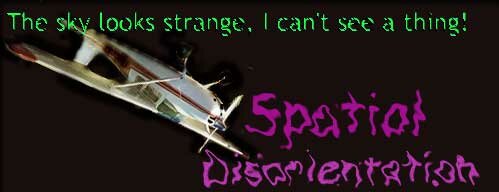

I'm not afraid! Send me back to the Bermuda Triangle
Spatial Disorientation
One of the most beautiful views in the World is standing on a beach looking out at the ocean on calm summer night. The ocean is so peaceful and the sky so black that as you look out beyond where the water laps the shore, you would swear that you are standing at the edge of the universe. You don't see the horizon in the distance. Indeed all you see is the blackness of space, and this blackness is not a far off sight, it is an all consuming emotion that is as close as your fingertips. It surrounds you and bathes you. The serenity of the moment is the magic that inspires writers and brings out the dreams of poets. Such an image is as timeless as the Universe itself. It is also the stuff of a pilot's worst nightmare.
So often stories coming from the Bermuda Triangle have a dramatic ending with a pilot saying "I can't see anything" or "Everything looks strange" and then simply vanishing. The pilot is often described as in an approach for landing.
Actually the pilot believes he is flying level but is actually in a banking dive, unaware that he is just seconds from a fatal crash into the sea. Are undersea crystals pulling his plane to certain death? Has a UFO trapped him with a tractor beam? Has he been sucked into a space time vortex? If not, then what is happening.
How can this be explained? Most often the answer is Spatial Disorientation. A pamphlet distributed by the FAA says,
As a result, when you finally level the wings, that new change will cause your inner ear to produce signals that make you believe you're banking to the right. This is the crux of the problem you have when flying without instruments in low visibility weather.
Even the best of pilots will quickly become disoriented if they attempt to fly without instruments when there are no outside visual references. That's because vision provides the predominant and coordinating sense we rely upon for stability.
Often, when we read stories about the Bermuda Triangle the weather is described as calm or without a cloud in the sky. When a pilot is flying over water at night, this translates into "no visible horizon".
Without this horizon, even the most seasoned pilot must rely on instruments in order to determine if he is flying level. Without the horizon the pilot can be become confused and disoriented in a matter of seconds. The problem is compounded if severely if alcohol is involved.
Pilots who have their instrument rating are better able to handle spatial disorientation, but the FAA cautions that "rating alone is no automatic guarantee because there is no such thing as `knowing how to fly on instruments.You must continue to practice your skills. You are either formally trained and current or you are unqualified."
Even after a pilot has his instrument rating they must requalify with an instructor a minimum of every two years. The FAA pamphlet continues.
Or to put it in the words of promoters of the myths "The plane began to circle for a landing and then suddenly within sight of the tower it disappeared". In reality the plane dropped from radar and was never really in visual contact. And within seconds, the plane crashed into the sea without a May Day because the pilot never even knew he was in a graveyard spiral.